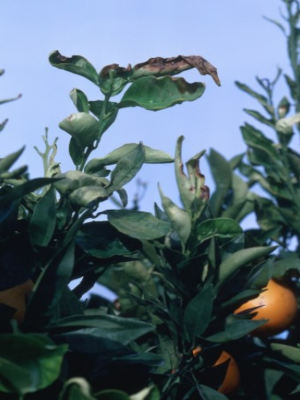Where a tree is planted can affect whether or not it is damaged by frost. Trees that are growing in open areas are more likely to suffer frost damage. Cold air tends to collect in low areas, so avoid these sites as well when planting citrus. On the other hand, trees can benefit from reflected and reradiated heat if they are planted near walls or other structures.
Certain cultural practices can also mitigate frost damage. Healthy, well-irrigated trees are better able to endure freezing temperatures. The full, leafy canopy of a healthy tree also helps shelter the fruit. In addition, moist soil retains heat better than dry soil and can actually warm the air near the soil surface. It is also a good idea to keep the ground around trees bare during the winter months. Bare, moist soil is better able to absorb and reradiate heat than soil insulated with mulch, weeds, or other ground covers. Fertilizing and pruning both encourage new growth, and delicate new growth is far more frost-sensitive than mature foliage. Thus, pruning and fertilizing of citrus trees should occur in the spring and early summer in order to give the new vegetation time to mature and harden off before cold weather sets in.

Frost-damaged citrus, UC Integrated Pest Management
A light bulb (100-watt, designed for outdoor use), or Christmas lights hung in the middle of a tree can provide frost protection if the lights are the “old-fashioned” incandescent type that actually release significant heat. When a hard freeze is predicted, watering all night with sprinklers can also protect trees from frost damage. This only works if water is applied continuously. If the water supply is interrupted, more damage may result than would have otherwise occurred. Additionally, don't forget that this practice uses a lot of water and is considered inappropriate for our currently drought-stricken dry California climate.
Frost-sensitive young trees can be protected by wrapping them with insulating material from the ground up to the main branches. In frost-prone areas, you might also consider covering trees that are one to three years old entirely, using a light material to trap heat being radiated by the ground. A frame or stakes should be used to minimize contact between the cover and leaves because ice may form where the cover touches any leaves. Sheets, burlap, or tarps are a better choice of cover material than plastic because plastic transfers more heat and if leaves come in contact with it they are more likely to freeze. The cover should extend as close to the ground as possible and be removed the next morning after the temperature rises.
If trees do show signs of frost damage, resist the urge to prune out “dead” wood in the early spring. Allow a few months for the trees to recover with the return of warm weather. Once new growth appears, the actual extent of the frost damage will be apparent and frost-killed branches can be removed without accidentally pruning out living material.
Source : ucanr.edu